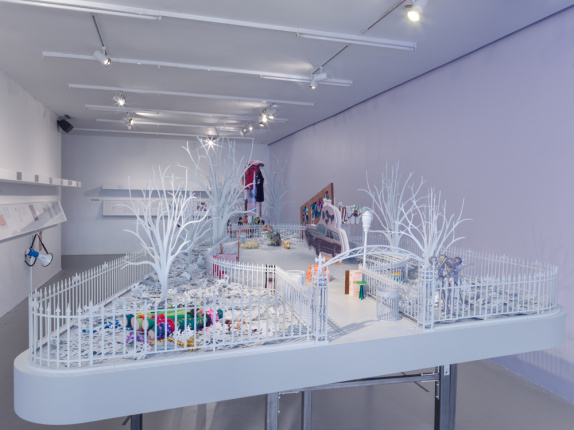“MOTHA and Chris E. Vargas: Consciousness Razing—The Stonewall Re-Memorialization Project” will be the exhibition and residency presented through the Department of Education and Public Engagement’s Fall 2018 R&D Season: Generation.
“MOTHA and Chris E. Vargas: Consciousness Razing—The Stonewall Re-Memorialization Project,” 2018. Exhibition view: New Museum, New York. Photo: Maris Hutchinson / EPW Studio
Fifth Floor Visit Us
Interested in learning more? Download the audio guide
With wry humor and incisive critique, Chris E. Vargas parodies mainstream social and institutional codes to reimagine how queer and trans experiences are represented. Vargas is the founder of the Museum of Transgender Hirstory & Art (MOTHA), a semi-fictional, transient institution that serves as a platform for exhibiting trans history and cultural production. His project takes up the contested legacy of the word history: Vargas notes that “for millennia, the patriarchy has had versions of history; for a few years in the 1970s, some white feminists had herstory; but it hasn’t been until now that transgender people have finally had a gender-neutral hirstory all their own.”
At the New Museum, Vargas continues work on his project Transgender Hirstory in 99 Objects (2015–ongoing), a visual and material exploration of significant artifacts in the history of transgender communities. Major museums often present one hundred objects from their collections to construct “definitive” historical narratives; in his series, Vargas riffs on this convention, purposefully presenting ninety-nine or fewer objects to emphasize the forever-incomplete task of representing history. A creative and critical exploration of LGBTQI archives, Vargas’s project takes the form of exhibitions (of which this is the fifth), publications, and touring performances in which the artist appears as the Executive Director of MOTHA.
This iteration of the project explores Stonewall as a geographically, demographically, and historically contested site. Throughout MOTHA’s four-month exhibition, Vargas questions what we think we know about the 1969 Stonewall riots in New York, often cited as a formative event for gay liberation and the modern LGBTQI civil rights movement in the United States. In 2016, to commemorate the riots, President Obama designated the Stonewall Inn and the adjacent Christopher Park a national monument. Yet for years, many of the activists who led the fight against violence and police brutality against queer and trans people—including Sylvia Rivera, Marsha P. Johnson, Miss Major Griffin-Gracy, and many others—were not properly credited in popular accounts of Stonewall. Today, mainstream LGBTQI histories increasingly recognize these figures, even while eliding their more radical demands and their critiques of racism, economic marginalization, and transphobia.
In order to expand how this complex history is memorialized, and to acknowledge the ways it has been manipulated, Vargas has invited an intergenerational group of artists to propose new monuments to the riots. These commemorations—by Chris Bogia, Jibz Cameron, Nicki Green, Martine Gutierrez, Sharon Hayes, Thomas Lanigan-Schmidt, Catherine Lord, Devin N. Morris, D’hana Perry, Keijaun Thomas, Geo Wyeth, and Sarah Zapata—take up Stonewall’s legacy through radically different forms and on divergent terms. In the Fifth Floor Gallery, a 1:7 scale model of Christopher Park becomes a platform for wildly speculative public art. Maquettes and plans by the contributing artists are on view during the run of Vargas’s exhibition, replacing the George Segal sculptures that have been installed in the park since the early 1990s. The models cycle through the park, variously building, renovating, and razing an iconic landscape. At stake is the place of imagination within revolution, bolstered by Vargas’s insistence that rather than simply substituting one object—or one history, memory, or concern—for another, we must hold space for many.
Vargas’s residency and resulting collaborative project reflect on the theme of the Department of Education and Public Engagement’s Fall 2018 R&D Season: GENERATION. Most obviously, the term generation refers to the ways culture and history are handed down over time via affiliation. Yet the word also conjures ways of making, of creating and bringing forth. With both meanings in mind, Vargas looks to Stonewall as a perpetually unfolding site. Rather than construct a neat historical trajectory, his project contends that attempting to narrate a stable history does the past a disservice. Instead, MOTHA concedes that the act of historicizing is inherently biased and often self-serving, and finds new ways to uncover, recast, and recuperate elements of the past.
The exhibition is curated by Johanna Burton, Keith Haring Director and Curator of Education and Public Engagement, and Sara O’Keeffe, Associate Curator, with Kate Wiener, Curatorial Assistant.
Chris E. Vargas (b. 1978) is a video-maker and interdisciplinary artist originally from Los Angeles and currently based in Bellingham, WA. From 2008 to 2013, Vargas collaborated with Greg Youmans to make the web-based trans/cisgender sitcom Falling In Love . . . with Chris and Greg. With Eric Stanley, he codirected the short film Homotopia (2006) and its feature-length sequel Criminal Queers (2015), which have screened at Palais de Tokyo, Paris; LACE, Los Angeles; Centre for Contemporary Arts Glasgow; the New Museum; and other venues. He is the executive director of the Museum of Transgender Hirstory & Art (MOTHA), a conceptual arts and hirstory institution that highlights trans art’s contributions to the cultural and political landscape. Iterations of MOTHA have been presented at the Henry Art Gallery, Seattle (2016); Hammer Museum, Los Angeles (2014); and Yerba Buena Center for the Arts, San Francisco (2013).





